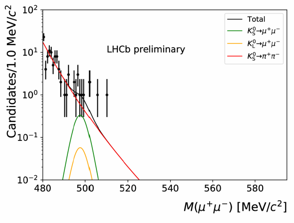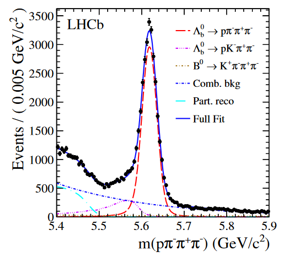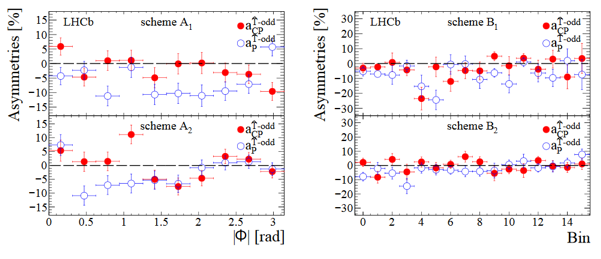The LHCb Collaboration presented interesting new results at the International Conference on Kaon Physics 2019 in Perugia, Italy, and at the International Conference on B-physics at frontier machines, Beauty 2019 in Ljubljana, Slovenia. Selected topics are listed below.
(1) Hunting for the rarest strange decays at the LHC, KS0→μμ. Decays of K mesons into pairs of muons played a very important role in the history of particle physics. There are two types of neutral K mesons: the short-lived KS0 (“K-short”), and the long-lived KL0 (“K-long”). The results of branching-ratio measurements of the K-long decay into muon pairs in the early 1970s disagreed strongly with the predictions of the particle physics theory of the time, based on the existence of three quarks: u, d and s. The branching ratios were calculated to be of the order of 10-4 while the experimental limits were about 4 orders of magnitude lower. In an attempt to solve this problem Glashow, Iliopoulos and Maiani proposed the existence of an additional quark, called a charm quark – a 1970s version of a new physics model. In the mechanism they proposed (GIM mechanism) a destructive virtual contribution of this new quark greatly reduced the K-long decay rate into muon pairs. The discovery of the J/ψ meson in November 1974 was the first evidence for the existence of charm quark, and at the same time confirmation of the GIM mechanism.
45 years later, LHCb physicists are searching for K-short decays into muon pairs, again on the look-out for new physics. This decay rate is very sensitive to possible contributions from new, yet-to-be discovered particles, such as leptoquarks or super-symmetric particles that are too heavy to be observed directly at the LHC. These could significantly enhance the decay rate, up to existing experimental limits, but could also suppress it, as the charm-quark contribution to the K-long decay did. In the same way, the long-running search for the very rare decay of a Bs0 meson into a muon-antimuon pair was motivated by the search for new physics. According to the Standard Model, the expected decay rate of KS0 →μμ is about thousand times smaller than that of Bs0→μμ, making the search particularly challenging. The analysis required a sophisticated online (real-time) selection, and made use of machine-learning tools and parallel processing with graphics processing units (GPUs). In the absence of a significant signal (see image), an upper limit on the branching fraction of 2.1 × 10-10 is obtained, four times more stringent than the previous best limit, which was also set by LHCb.
Read more in the LHCb conference presentation, in the conference note, in the CERN Courier article and in the LHCb paper.
(2) Observation of parity violation and search for CP-violation in Λb0→pπ–π+π– decays. Charge-parity (CP) violation – a difference in behaviour between matter and antimatter – is a well-established phenomenon in the decays of K and B mesons. Recently, it has also been observed by the LHCb collaboration in the decays of D mesons. However, CP violation has yet to be established in baryonic decays. Similarly, parity violation is well established in weak interactions, but has never been observed in b-hadron decays. (In weak decays of hadrons, parity violation depends on the hadron’s constituents.)
Physicists from LHCb reported the first observation of parity violation in b-baryon decays, with a significance of over 5 standard deviations, using a sample of Λb0→pπ–π+π– decays. Searches for CP violation were also performed, giving results that are marginally compatible with the hypothesis of no-CP violation.
The left image above shows the pπ–π+π– invariant mass spectrum with an accumulation at the Λb0 mass. The other images show measured asymmetries by grouping data in different ways (different binning schemes), with horizontal black dashed lines at zero representing the hypothesis of P and CP conservation. The open blue points are inconsistent with this null hypothesis and show clear evidence of parity violation, the first observation of the phenomenon in b-baryon decays, while the red full points do not show evidence of CP violation when a statistical test is applied. A second, complementary analysis method is used in which, rather than grouping the data into bins, a single test is used to measure how well the underlying distributions of data points overlap. The result obtained from this method constitutes an observation of parity violation with over 5 standard deviations significance.
Read more in the LHCb conference presentation, in the LHCb CERN seminar and in the paper. This result is an update to a previous paper, which used about four times less signal.
(3) Search for the doubly charmed baryon Ξcc+. The LHCb collaboration discovered the exceptionally charming particle Ξcc++ in 2017. It is a baryon containing two charm quarks and one up quark (ccu), resulting in an overall doubly positive charge. It is the doubly charmed counterpart of the well-known lower-mass Ξ0 baryon, which is composed of two strange quarks and an up quark (ssu). The Ξcc++ was then rediscovered in different decay mode and its lifetime has been measured.
Other, similar combinations of quarks are also possible. If the u quark of a Ξcc++ baryon is replaced by a d quark, one obtains a singly charged Ξcc+ baryon (ccd), which is expected to have a similar mass but a much shorter lifetime according to a number of theoretical calculations. LHCb physicists reported the results of a search for this particle in the decay chain Ξcc+→Λc+K–π+, Λc+→pK–π+, using the full Run1 and Run2 data sample.
The left image above shows the pK–π+ invariant mass spectrum in which events accumulate around the Λc+ mass. Milions of Λc+ baryons are selected with high purity. The right image shows the Λc+K–π+ invariant mass spectrum. A search is carried out for a possible “bump” that would indicate evidence for the Ξcc+ baryon in the “RS” (right-sign) distribution; the “WS” (wrong-sign) spectrum is a control channel where no structure is expected to show up. No significant signal is observed and, since LHCb’s ability to reconstruct these particles depends strongly on how much the Ξcc+ baryon flies before decaying, a suite of limits are reported under different Ξcc+ lifetime hypotheses. The dashed blue line indicates the mass of the Ξcc++ baryon discovered by LHCb, and the dotted red line indicates the mass of the Ξcc+ baryon reported by SELEX experiment at Fermilab.
Read more in the LHCb conference presentation and in the LHCb paper.




